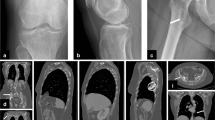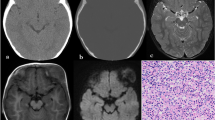Abstract
Magnetic resonance (MR) images of 12 pathologically proven lesions of Langerhans cell histiocytosis (LCH) of bone were reviewed retrospectively. MR identified all lesions, three of which were not identified on plain radiographs. In all cases, MR showed greater abnormality than did plain radiographs. With one exception, all lesions were hypointense on T1-weighted images and hyperintense on T2-weighted images. The lesions and associated soft tissue abnormalities were very conspicuous on short TI inversion sequences and T1-weighted post-contrast images. Follow-up MR studies in two patients after chemotherapy showed decreased size and enhancement of lesions compared with baseline studies.
Similar content being viewed by others
References
Stull MA, Kransdorf MJ, Devaney KO (1992) Langerhans cell histiocytosis of bone. Radiographics 12: 801–823
Beltran J, Aparisi F, Bonmati LM et al (1993) Eosinophilic granuloma: MRI manifestations. Skeletal Radiol 22: 157–161
Siddiqui AR, Tashjian JH, Lazarus K et al (1981) Nuclear medicine studies in evaluation of skeletal lesions in children with histiocytosis X. Radiology 140: 787–789
De Schepper AMA, Ramon F, Van Marck E (1993) MR imaging of eosinophilic granuloma. Skeletal Radiol 22: 163–166
David R, Oria RA, Kumar R et al (1989) Radiologic features of eosinophilic granuloma of bone. AJR 153: 1021–1026
Mulligan ME, Kransdorf MJ (1993) Sequestra in primary lymphoma of bone: prevalence and radiologic features. AJR 160: 1245–1248
Vogler JB, Murphy WA (1988) Bone marrow imaging. Radiology 168: 679–693
Cohen MD, Klatte EC, Baehner RL et al (1984) Magnetic resonance imaging of bone marrow disease in children. Radiology 151: 715–718
Sundaram M, McLeod RA (1990) MR imaging of tumor and tumorlike lesions of bone and soft tissue. AJR 155: 817–824
Totty WG, Murphy WA, Lee JKT (1986) Soft tissue tumors: MR imaging. Radiology 160: 135–141
Beltran J, Simon DC, Katz W, Weis LD (1987) Increased MR signal intensity in skeletal muscle adjacent to malignant tumors: pathologic correlation and clinical relevance. Radiology 162: 251–255
Kransdorf MJ, Jelinek JS, Moser RP (1993) Imaging of soft tissue tumors. Radiol Clin North Am 31: 359–372
Dwyer AJ, Frank JA, Sank VJ et al (1988) Short-T1 inversion recovery pulse sequence: analysis and initial experience in cancer imaging. Radiology 186: 827–836
Vanel D, Lacombe M, Couanet D et al (1987) Musculoskeletal tumors: follow-up with MR imaging after treatment with surgery and radiation therapy. Radiology 164: 243–245
Holsher HC, Bloem JL, Nooy MA et al (1990) The value of MR imaging in monitoring the effect of chemotherapy on bone sarcomas. AJR 154: 763–769
Author information
Authors and Affiliations
Rights and permissions
About this article
Cite this article
George, J.C., Buckwalter, K.A., Cohen, M.D. et al. Langerhans cell histiocytosis of bone: MR imaging. Pediatr Radiol 24, 29–32 (1994). https://doi.org/10.1007/BF02017655
Received:
Accepted:
Issue Date:
DOI: https://doi.org/10.1007/BF02017655




